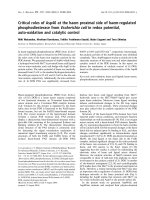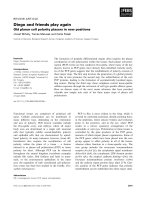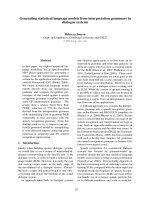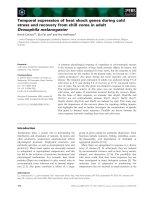Developing away from home sales in New Toyo Pulppy (Vietnam) Co.
Bạn đang xem bản rút gọn của tài liệu. Xem và tải ngay bản đầy đủ của tài liệu tại đây (520.92 KB, 115 trang )
OPEN UNIVERSITY
HO CHI MINH CITY
UNIVERSITEÙ LIBRE DE BRUXELLES
SOLVAY BUSINESS SCHOOL
MMVCFB 6
VIETNAM – BELGIUM MASTER IN MANAGEMENT PROGRAM
DO NGOC HOA
DEVELOPING AWAY FROM HOME SALES
IN NEW TOYO PULPPY (VIETNAM) CO. LTD.
MASTER IN MANAGEMENT THESIS
HO CHI MINH CITY
2007
OPEN UNIVERSITY
HO CHI MINH CITY
UNIVERSITEÙ LIBRE DE BRUXELLES
SOLVAY BUSINESS SCHOOL
MMVCFB 6
VIETNAM – BELGIUM MASTER IN MANAGEMENT PROGRAM
DO NGOC HOA
DEVELOPING AFH SALES
IN
NEW TOYO PULPPY (VIETNAM) CO. LTD.
MASTER IN MANAGEMENT THESIS
THESIS ADVISOR : DR. LE NGUYEN HAU
HO CHI MINH CITY
2007
i
TABLES OF CONTENTS
CHAPTER 1 – INTRODUCTION 1
BACKGROUND 1
1.1 PROBLEM STATEMENT 1
1.2 THESIS OBJECTIVES 2
1.3 SCOPE AND LIMITATION OF THE STUDY 3
1.4 ORGANIZATION OF THE STUDY 3
CHAPTER 2 – THEORETICAL BACKGROUND 5
BUSINESS MARKET AND BUSINESS BUYING BEHAVIOR 5
2.1 SEVERAL CHARACTERISTICS OF BUSINESS MARKET 5
2.2 CLOSE SUPPLIER – CUSTOMER RELATIONSHIP 6
2.3 MAJOR TYPES OF BUYING SITUATIONS 6
2.4 WHO PARTICIPATES IN THE BUSINESS BUYING PROCESS? 7
2.5 CONCEPT OF MARKETING STRATEGY 8
2.6 LINK BETWEEN MARKETING STRATEGY AND CORPORATE STRATEGY 9
2.7 STRATEGIC MARKETING PLANNING PROCESS 10
2.7.1 MARKETING SITUATION ANALYSIS 10
2.7.2 MARKETING STRATEGY DESIGN 13
2.7.3 MARKETING PROGRAM DEVELOPMENT 17
2.7.4 IMPLEMENTING AND MANAGING MARKETING STRATEGY 25
CHAPTER 3 – RESEARCH METHOD 28
3.1 ANALYTICAL FRAMEWORK 28
3.2 INFORMATION NEEDED 31
3.3 DATA SOURCES 32
3.4 DATA COLLECTION METHOD 32
CHAPTER 4 – EXTERNAL ANALYSIS 34
AN OVERVIEW OF THE VIETNAMESE ECONOMY 34
4.1 SOME ECONOMIC ACHIEVEMENTS OF HCMC AND BINH DUONG PROVINCE 36
4.2 VIETNAMESE PAPER MARKET 37
4.2.1 PRODUCTION 37
ii
4.2.2 FORECAST OF PRODUCTION AND CONSUMPTION OF TISSUE PAPER TO 2010 39
4.3 CONSUMPTION PATTERN AND CONSUMER PREFERENCE 40
4.3.1 CONSUMPTION PATTERN 40
4.3.2 CONSUMER PREFERENCE 41
4.4 COMPETITION ON THE VIETNAMESE TISSUE PAPER MARKET 41
CHAPTER 5 – ANALYSIS OF MAIN COMPETITORS OF NPV 42
MAIN COMPETITORS 42
5.1 PROFILE OF SAIGON PAPER CORPORATION 42
5.2 ASIA PULP AND PAPER (APP) 46
5.3 VIDON PAPER JOINT STOCK COMPANY (VIDON) 48
5.4 SUBSTITUTES 50
5.5 SUMMARY OF OPPORTUNITIES AND THREATS OF NPV 51
5.5.1 OPPORTUNITIES 51
5.5.2 THREATS 53
CHAPTER 6 – INTERNAL ANALYSIS 54
PROFILE OF NPV 54
6.1 MISSION OF NPV 54
6.2 MARKETING OBJECTIVE OF NPV 55
6.3 PRODUCTION AND BUSINESS RESULTS 55
6.4 PRODUCTION CAPACITY 55
6.5 VALUE SHARE AND SALES VOLUME OF AFH 56
6.6 ANALYSIS OF MARKETING ACTIVITIES 57
6.6.1 PRODUCT 57
6.6.2 NPV’S PRODUCT LINE SALES 62
6.6.3 PACK TYPES 63
6.7 PRICE 63
6.7.1 PRICING OBJECTIVES 63
6.7.2 PRICING LIST 64
6.7.3 PRICING STRUCTURE 64
6.8 DISTRIBUTION CHANNELS SYSTEM 64
6.8.1 DISTRIBUTION OBJECTIVE 64
6.8.2 PROMOTION ACTIVITIES 65
6.9 RESULTS AND DISCUSSION OF CONSUMER SURVEY 67
6.10 HOW CONSUMERS CHOOSE TO BUY A TISSUE PAPER PRODUCTS 68
6.11 ATTRIBUTES OF TISSUE BRANDS 68
iii
6.12 PRICES OF BATHROOM BRANDS 69
6.13 SUMMARY OF NPV’S STRENGTHS AND WEAKNESSES 69
6.13.1 STRENGTHS 70
6.13.2 WEAKNESSES 71
SWOT MATRIX 72
6.14 DEVELOPING THE MARKETING STRATEGIES FOR NPV 73
6.14.1 MARKET SEGMENTATION 73
6.14.2 NPV MARKET TARGETING 74
6.14.3 POSITIONING STRATEGY 74
6.15 DEVELOPING MARKETING MIX STRATEGY FOR AFH 75
6.15.1 PRODUCT STRATEGY 76
6.15.2 PRICE STRATEGY 77
6.15.3 DISTRIBUTION STRATEGY 78
6.15.4 PROMOTION STRATEGY 79
CHAPTER 7 – CONCLUSIONS AND RECOMMENDATIONS 81
CONCLUSIONS 81
RECOMMENDATIONS FOR FURTHER RESEARCH 83
COMMITMENT DECLARATION
I commit that this is my own study. All figures and results stated in this
thesis are true.
DO NGOC HOA
ABBREVIATION
NPV New Toyo Pulppy (Vietnam) Co. Ltd.
CS Consumer Sales
AFH Away From Home Sales
tpy tons per year
tpd tons per day
APP Asia Pulp and Paper
VP virgin pulp
DIP de-inked pulp
SOE State-owned-enterprise
ABSTRACT
New Toyo Pulppy (Vietnam) Co. Ltd., (NPV) is a wholly owned subsidiary of Benline
Investment (Hong Kong) and is one of the largest and modern factories in Vietnam.
The company produces well-known tissue paper brands such as Pulppy, May, AnAn
and SSS. Together economic development, the Vietnamese tissue paper industry has
developed and the Vietnamese tissue paper market becomes fiercely competitive. NPV
is facing the question of how to protect its leading position in the market, as well as to
increase sales.
This study deals with the development of marketing strategies for NPV. Thus, it is
necessary to analyze external factors including production and consumption,
competition to identify opportunities and threats in environment in which the company
operates. Moreover, the analysis and assessment of production and business of NPV
need to discuss to find out its strengths and weaknesses. Following the analysis the
opportunities threats, as well as strengths and weaknesses, the marketing strategies also
are recommended to achieve the marketing objective of the company.
LIST OF FIGURES
Figure 1: Strategic marketing process 12
Figure 2: Selecting a marketing strategy 16
Figure 3: Price determination process 21
Figure 4: Analytical framework 30
Figure 5: GDP growth rate in Vietnam during 1995-2006 35
Figure 6: Production, consumption 1996-2005 40
Figure 7: The current production capacity of Saigon Paper 43
Figure 8: Value shares of Saigon brands in 2005 44
Figure 9: Product and Price of Saigon Paper 44
Figure 10: Value shares of Paseo brands in 2005 47
Figure 11: Product and Price of APP 47
Figure 12: Product and Price of Vidon 50
Figure 13 : Contribution of segments in AFH sales in 2006 55
Figure 14: Contribution of territory of AFH market 56
Figure 15: NPV’s monthly sales volume 2003-2006 57
Figure 16: Unaided brand awareness_Toilet rolls 59
Figure 17: Aided brand awareness_Toilet rolls 60
Figure 18: Unaided brand awareness _ Napkins 61
Figure 19: Products analysis (2006) 63
Figure 20: Distribution channels of NPV 65
Figure 21: Profile of sampling size 68
Figure 22: Comparison the attributes of selected brands 69
Figure 23: SWOT analysis 72
Developing AFH sales in NPV MMVCFB6
Do Ngoc Hoa 1
Chapter 1
INTRODUCTION
Background
Transition from a centrally planned economy to market-economic structure, the
Vietnamese market becomes more dynamic. All business and production activities are
encouraged to contribute into economic growth and stabilization of the nation. Like
other light industries, investment in tissue paper is welcomed and facilitated. The
Vietnamese tissue paper industry has rapidly developed. Together with the raising
living standard, the demand for tissue paper quickly increases and high quality brands
are much preferred.
More and more foreign tissue paper producers and worldwide distributors enter
into the Vietnamese market. At present, all players are facing the fierce competition
between local and foreign brands. There are more than 55 local producers who produce
more than 80 tissue paper brands including Pulppy, Kleenex, Paseo, Kissme, Vidon,
Vinh Hue, Alice, etc.
The tissue products being sold in the market can be divided into categories:
towels, toilet roll, napkins, facial, medical paper and products used in industry.
By Some local producers such as NPV, Saigon Paper, Vien Dong, Vinh Co etc. having
both Consumer sales (CS) and Away-from-home (AFH) sales. However, AFH sales is
underdeveloped properly because it is quite new in Vietnam market.
1.1 Problem statement
Vietnam tissue paper market is underdeveloped and is very attractive to all
tissue paper manufacturers in domestic or overseas. According to the Vietnam Paper
Association, demand on tissue paper consumption in Vietnam in the next 10-15 years
is very huge. Currently, the average paper consumption of Vietnam is about 10-15kg
Developing AFH sales in NPV MMVCFB6
Do Ngoc Hoa 2
per person per year compared to 32 kg/person/year in Asia and 50-60kg/person/year in
Europe.
New Toyo Pulppy (Vietnam) Co. Ltd., (NPV) is one of the largest and modern
factories in Vietnam. Since 2000, its brands such as Pulppy, May, AnAn and SSS are
accepted by domestic consumers as high quality products with reasonable price. NPV
has three sales divisions in which two are Domestic sales and one is Export sales. The
Domestic sales consist of two divisions CS and AFH.
NPV has set up a distribution network nationwide for the Consumer sales. Its
products are delivered from its tissue mill in Binh Duong province. The AFH is
present in Ho Chi Minh City and Binh Duong province.
The competition in tissue paper market became fierce in recent years with new
investments of tissue manufacturers in Vietnam. In addition, some foreign companies
in Thailand and Indonesia started operation in Vietnam made the market competition
become intensified.
In this high growth and high competition market situation, how can NPV
develop effective marketing strategies for getting more success in its target market?
How does it survive in the intensified competition of local companies and international
companies in the future? To answer these questions, NPV needs to develop a proper
marketing strategy to quickly develop potential market to gain shares.
This study aims at developing AFH sales in New Toyo Pulppy (VN) Co. Ltd in
order to increase the market share and protect its leading position in the tissue paper
market.
1.2 Thesis objectives
The objectives of this study cover the following issues:
Developing AFH sales in NPV MMVCFB6
Do Ngoc Hoa 3
Ü To analyze the potentiality of the AFH market in Ho Chi Minh city and Binh
Duong province.
Ü To analyze the competitors capacity and their potential development in the AFH
market.
Ü To develop new products, based on existing products and brands, suitable to
each segment in order to develop AFH and create competitive advantages.
1.3 Scope and Limitation of the Study
This study is conducted at NPV in Ho Chi Minh city, Vietnam. The study has
been undertaken purely from a view-point of marketing relating to develop the market
penetration strategies for NPV in Ho Chi Minh city and Binh Duong province.
Products using in this penetration strategies are NPV existing products and brands.
This study relates to the development of the marketing strategies including
market segmentation, market targeting, product strategy, positioning strategy and
marketing mix for products, price, distribution, and promotion.
In the area of distribution, the physical distribution channels such as inventory,
logistic, warehouse, and transportation are not included.
Primary data are collected in Ho Chi Minh City and Binh Duong province
where the NPV believes that these areas are good for Away-from-home (AFH) market.
1.4 Organization of the Study
This study is organized in 7 chapters, as follows:
Ü Chapter 1 provides an introduction including background, problem statement,
objectives, scope and limitation of the study.
Ü Chapter 2 presents the theoretical background of the study. It relates to the
fundamental ideas on designing marketing strategies including marketing situation
Developing AFH sales in NPV MMVCFB6
Do Ngoc Hoa 4
analysis, marketing strategy design, marketing program development for products,
price, distribution and promotion and implementing and managing marketing
strategy. It also presents the characteristics of business market and implications to
NPV.
Ü Chapter 3 discusses research method including the analytical framework,
information needed, methodology of data collection, sampling size and data
analysis. It specifies two types of information: know-how and know-what to
develop the marketing strategy for NPV.
Ü Chapter 4 analyzes external factors covering the tissue paper market situation to
find out size, growth and possibility of AFH market. The outcomes of this analyzes
show the opportunities, threats and buying behavior.
Ü Chapter 5 presents the internal analysis regarding to capacity, brand, product, price,
promotion and distribution of NPV.
Ü Chapter 6 analyzes and assesses the current position of NPV through SWOT
analysis to present the strategic development and selection.
Ü Chapter 7 presents conclusion and recommendations.
Developing AFH sales in NPV MMVCFB6
Do Ngoc Hoa 5
Chapter 2
THEORETICAL BACKGROUND
This chapter discusses the general concepts which relate to the fundamental
ideas on business markets and business buying behavior, characteristics of business
market, designing marketing strategies including marketing situation analysis,
marketing strategy design, marketing program development for products, price,
distribution and promotion, and implementing and managing marketing strategy.
General concepts of business-to-business are also presented.
Business markets and business buying behavior
Several considerations not normally found in consumer marketing (Kotler,
1994):
• Organizations buy goods and services to satisfy a variety of goals: making profits,
reducing costs, meeting employee needs, and satisfying legal obligations.
• More persons typically participate in organizational buying decisions than in
consumer buying decisions, especially in procuring major items. The decision
participants usually represent different departments and apply different criteria to
the purchase decision.
• The buyers must heed the formal purchasing policies, constraints, and requirements
established by their organizations.
• The buying instruments, such as requests for quotations, proposals and purchase
contracts, add another dimension not typically found in consumer buying.
2.1 Several characteristics of business market (Kotler, 1994)
- Fewer buyers
Developing AFH sales in NPV MMVCFB6
Do Ngoc Hoa 6
- Larger buyers
- Close supplier customer relationship
- Geographically concentrated buyers
- Derived demand
- Inelastic demand
- Fluctuating demand
- Professional purchasing
- Several buying influences
- Miscellaneous characteristic: reciprocity
2.2 Close supplier-customer relationship
Because of the smaller customer base and the importance and power of the
larger customers, we observe relationships between customers and suppliers in
business markets. Suppliers are frequently expected to customize their offerings to
individual business customer needs. (Kotler, 1994).
2.3 Major types of buying situations
Straight rebuy: the straight rebuy describes a buying situation where the
purchasing department reorders on a routine basis. The buyer chooses from suppliers
on its “approved list”, giving weight to its past buying satisfaction with the various
suppliers. The “in-suppliers” make an effort to maintain product and service quality.
They often propose automatic reordering systems so that the purchasing agent will save
reordering time. The “out-suppliers” attempt to offer something new or to exploit
dissatisfaction so that the business buyer will consider buying some amount from them.
Out-suppliers try to get a small order and then enlarge their “purchase share” over time.
Developing AFH sales in NPV MMVCFB6
Do Ngoc Hoa 7
Modified rebuy: the modified rebuy describes a situation where the buyer wants
to modify product specifications, prices, delivery requirements, or other terms. The
modified rebuy usually involves additional decision participants on both the buyer and
seller sides. The in-suppliers become nervous and have to protect the account. The
out-suppliers see an opportunity to propose a “better offer” to gain some business.
New task: The new task describes a purchaser buying a product or service for
the first time. New task buying passes through several stages. Ozanne and Churchill
(1992) identified the stages as awareness, interest, evaluation, trial and adoption.
They found that communication tools varied in effectiveness at each stage. Mass
media were most important during the initial awareness stage; salespeople had their
greatest impact at the interest stage; technical sources were the most important during
the evaluation stage. Marketers needed to employ different tools at each stage of the
new task buying process.
2.4 Who participates in the business buying process?
Purchasing agents are influential in straight-rebuy and modified-rebuy
situations, whereas other department personnel are more influential in new-buy
situations. Engineering personnel usually have major influence in selecting product
components, and purchasing agents dominate in selecting suppliers. (Kotler, 1994).
Webster and Wind call the decision making unit of a buying organization the
buying center, defines as “all those individuals and groups who participate in the
purchasing decision making process, who share some common goals and the risks
arising from the decisions” (Kotler, 1994). The buying center includes all members of
the organization who play any of six roles in the purchase decision process (Kotler,
1994):
Users: Users are those who will use the product or service. In many cases, the
users initiate the buying proposal and help define the product specifications.
Developing AFH sales in NPV MMVCFB6
Do Ngoc Hoa 8
Influencers: influencers are persons who influence the buying decision. They
often help define specifications and also provide information for evaluating
alternatives. Technical personnel are particularly important as influencers.
Deciders: Deciders are persons who decide on product requirements and/or on
suppliers.
Approvers: Approvers are persons who authorize the proposed actions of
deciders or buyers.
Buyers: Buyers are persons who have formal authority to select the supplier and
arrange the purchase terms. Buyers may help shape product specifications, but they
play their major role in selecting vendors and negotiating. In more complex purchases,
the buyers might include high-level managers participating in the negotiations.
Gatekeepers: Gatekeepers are persons who have the power to prevent sellers or
information from reaching members of the buying center. For example, purchasing
agents, receptionists and telephone operators may prevent salespersons from contacting
users or deciders.
2.5 Concept of Marketing Strategy
Nowadays, most of companies are increasingly embracing targeting marketing.
Target marketing helps sellers or suppliers identify marketing opportunities better. The
sellers can develop the right offer for each target market. They can adjust their prices,
distribution channels, and advertising to reach the target market effectively. Therefore,
designing the marketing strategy is very important for success. The marketing strategy
is always a determinant constituent of effective competitive strategy. Cravens (1994)
defined that marketing strategy is the analysis, strategy development, and
implementation activities in selecting market target strategies for the product-markets
in each business unit, setting market objectives, and developing, implementing, and
Developing AFH sales in NPV MMVCFB6
Do Ngoc Hoa 9
managing the marketing program positioning strategies designed to meet the needs of
the customers in each market target.
Strategic marketing is a market-driven process of strategy development, taking
account a constantly changing business environment and the need to achieve high
levels of customer satisfaction. Thus, marketing strategy builds competitive advantage
by combining the customer influencing strategies of the business into integrated array
of market-focused actions. Strategic marketing links the organization with the
environment and views marketing as a responsibility of the entire business rather than a
specialized function.
Because of marketing’s boundary orientation between the organization and its
customers, channels members, and competition, it is central to the business strategy
planning process. Strategic marketing provides the expertise for environmental
monitoring, for deciding what customer groups to serve, for setting product
specifications and for selecting which competitors to position against.
2.6 Link Between Marketing Strategy and Corporate Strategy
Corporate strategic planning involves the activities such as developing a clear
sense of the company’s mission, identifying the company’s strategic business units,
allocating resources to the various strategic business units, and expanding present
business and developing new ones to fill the strategic-planning gap. The corporate
strategy is concerned with what types of business the company as a whole should be in
and is therefore concerned with the scope. Marketing strategy, on the other hand is part
of functional strategy that emerges in each strategic business unit as part of corporate
strategy.
According to Guiltiwan and Paul (1991), corporate strategy is type of plan
which outlines how a firm should use its resources to produce and market a specific
array of products and services in order to achieve overall corporate objectives. In
Developing AFH sales in NPV MMVCFB6
Do Ngoc Hoa 10
essence, the corporate strategy provided a general statement. It defined the products in
which the organization would be involved but left open the details of how each product
or product line would be marketed.
While the corporate strategy presents a plan developed by top management to
guide the total organization, a marketing strategy is usually developed by a middle
manager to guide a firm’s activities for a product or a line of related products. More
specially, a marketing strategy is a plan that indicates how a manager deploys
marketing resources on an individual product or product line in order to achieve a
specified product objective (such as market-share growth or maximizing cash flow).
2.7 Strategic Marketing Planning Process
Various steps in designing strategic marketing planning within an industry can
be found in literature and basically there principles are all similar. An approach for
strategic marketing process consist of marketing situation analysis, designing
marketing strategy, marketing program development, and implementing and managing
marketing strategy (Craven, 1994). It is shown in Figure 1. So there is a need to discuss
this in more detail.
2.7.1 Marketing Situation Analysis
The marketing situation analysis is the first step in the design of new strategy or
examining an existing strategy. It comprises the external and internal environment
analysis. These analyses guide the choice of marketing strategies.
The marketing environment is a place where the company must start its search
for opportunities and possible threats. It consists of all the actors and forces that affect
the company’s ability to transact effectively with its target market. The external
environment can be divided into macro environment and micro environment.
Developing AFH sales in NPV MMVCFB6
Do Ngoc Hoa 11
The macro environment includes more general forces that often do influence the
long run activities of the company. It consists of economic, socio-cultural,
technological, political, legal forces in relation to the firm's total environment. Thus,
the achievements, difficulties and challenges of Vietnamese economy and
governmental policies will influence the development of the tissue paper industry.
The micro environment includes the actors in the company’s immediate
environment that affect its ability to serve its markets especially, the company itself,
suppliers, market intermediaries, consumers, competitors and public. One key aspect of
external analysis is evaluation of competitors' strategies, strengths and weaknesses.
Competitor analysis includes defining competitive arena, analyzing the strategic group
and describing and evaluating each key competitor in terms of strengths and
weaknesses. At present, the Vietnamese tissue paper market becomes fiercely
competitive. So the analysis of production, consumption and competition are necessary
to identify opportunities and threats for the company.
Developing AFH sales in NPV MMVCFB6
Do Ngoc Hoa 12
Figure 1: Strategic marketing process
Source: Cravens, 1994
Designing
Marketing Strategy
Market targeting
Positioning strategy
Marketing strategies
for selected situations
Planning for new products
Marketing Program
Development
Product portfolio strategy
Pricing strategy
Distribution strategy
Promotion strategy
Market Situation
Analysis
Analyzing markets
Market segmentation
Analyzing competition
Marketing information
systems and research
Implementing and
Managing
Marketing Strategy
Designing effective
organizations
Marketing strategy
implementation
and control
Developing AFH sales in NPV MMVCFB6
Do Ngoc Hoa 13
The internal environment analysis is to help the company recognizing itself in
terms of strengths and weaknesses. The internal analysis includes the corporation's
structure, resources, production and business and marketing activities. Corporation
resources are the assets that include people, managerial skills, financial circumstances,
facilities, information technology and the skills and abilities within functional areas.
In general, the situation analysis identifies opportunities and threats in the
business environment and the organization’s strengths and weaknesses. This
information helps companies deciding how, when and where to compete in a given
environment.
2.7.2 Marketing Strategy Design
Designing marketing strategy includes market segmentation and targeting,
positioning strategy and the marketing strategy choice.
Market segmentation and targeting
Market segmentation is the act of dividing a market into distinct groups of
buyers who might merit separate products and/or marketing mixes. The marketer tries
different variables to see which reveal the best segmentation opportunities. For each
segment, a customer-segment profile is developed.
After evaluating market segmentation, the companies have to target the best
market segment(s). Market targeting selects the people or organizations that company
wishes to serve in the product-market. To do this, it must first evaluate profit potential
of each segment, which is a function of segment size and growth, segment structural
attractiveness, and company objectives and resources. Then, company must decide how
many segments to cover. It can ignore segment differences (undifferentiated
marketing), develop different market offers for several segments (Differentiated
marketing) or go after one or a few market segment (concentrated marketing).
Developing AFH sales in NPV MMVCFB6
Do Ngoc Hoa 14
Thus, once the company’s product-markets are identified and their relative
importance to the firm determined, it selects the targeting strategy. This decision is the
focal point of marketing strategy, since targeting guides the setting of objectives and
developing a positioning strategy.
Positioning strategy
Regardless of the types of market coverage chosen, the company must develop
and communicate for every market selected. A positioning strategy clearly differentiate
it or its products from competitors. Positioning is the act of designing the company’s
offer so that it occupies a distinct and valued place in the target customers’ minds
(Kotler,1994).
Positioning strategy should take into account:
- The criteria or benefits the buyer considers when purchasing a product,
including the relative importance of the criteria.
- How the firm is differentiated from its competition.
- The limitations of competing products regarding important buyer needs and
wants.
The positioning strategy indicates how the firm or its brands would like to be
perceived in the eyes and minds of the market target customers. Therefore, decisions
about products, distribution channels, price, and promotion should create a cohesive
marketing program aimed at meeting the needs and wants of consumers in the firm’s
target market. The marketing program combines the firm’s marketing capabilities into
a package of actions intended to position the firm against its competitors.
Marketing strategy selection
Selecting a marketing strategy takes into account the factors such as the rate of
growth of product-market, the diversity in the needs and wants of buyers, the structure
Developing AFH sales in NPV MMVCFB6
Do Ngoc Hoa 15
of competition, the organization’s competitive advantage in which an organization
encounters. Strategy selection may involve the developing a new marketing strategy or
changing an existing strategy.
As argued by Guiltiwan and Paul (1991) to choose the best marketing strategy, a
manager must consider several kinds of information, as follows (Figure 2).
- Product objectives to help company determine the necessary basic type of strategy.
- Nature and size of the market opportunity should be clearly established based on
the market analysis and market measurements.
- Managers must have a sense of the success requirements in terms of the kinds of
competitive advantages necessary and the level of marketing expenditures that will
be necessary to meet profitability goals.
Craven (1990) proposed the comprehensive possibility of marketing strategy
alternatives that can be used to achieve marketing objectives. They consist of (1) new
product strategy, (2) market targeting strategy, (3) market program positioning
strategy, (4) productivity improvement strategy, (5) organizational design, (6)
exploiting special advantage, (7) acquisition/ merger/ strategic alliance and (8) exit
from market.
Developing AFH sales in NPV MMVCFB6
Do Ngoc Hoa 16
Figure 2: Selecting a marketing strategy
Source: Guiltiwan and Paul, 1991
Corporate Marketing
Planning
Product Objectives
Marketing Strategy
Size of
Market
Opportunity
Marketing
Budgets
Required
Needs of
Target
Markets
Market
Opportunity
Market
Analysis
Market
Measurement
Competitive
Analysis
Competitive
Advantages
Market Success
Requirements
Profitability and
Productivity
Analysis









